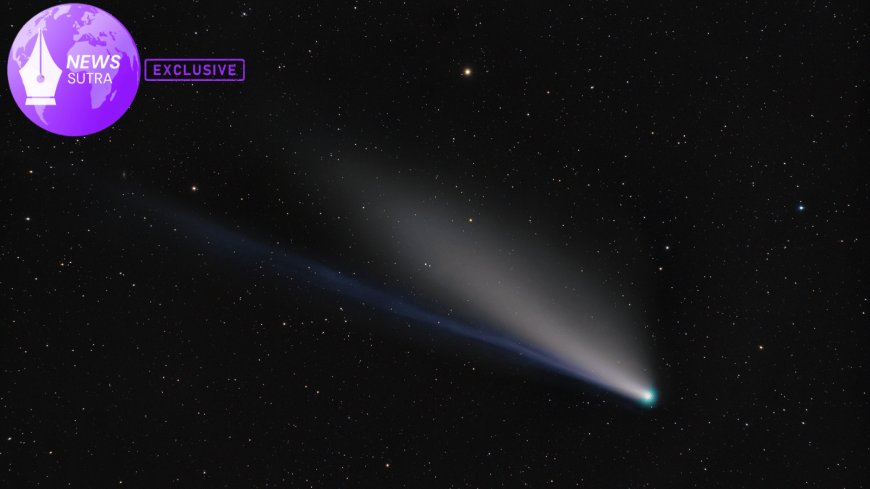Devil’s Comet Discovery: Shared Water Signature with Earth Challenges Origin of Life Theories
New spectroscopic data from Devil’s Comet shows water isotopes matching Earth’s oceans, reshaping theories about the origin of life and planetary formation.

For decades, astronomers have asked a fundamental question: Where did Earth’s water come from? Now, a discovery involving the so-called “Devil’s Comet” (12P/Pons-Brooks) may be reshaping that debate. Recent spectroscopic studies have revealed that water detected on this unusual comet carries the same isotopic fingerprint as Earth’s oceans — a finding that could transform our understanding of planetary formation and even the origin of life.
The Comet with a Fiery Reputation
The Devil’s Comet earned its nickname because of its frequent outbursts and glowing horn-like dust plumes, which have fascinated skywatchers. But beyond its dramatic appearance, the comet has now become a key subject in the search for life’s origins. Astronomers used high-resolution spectrographs mounted on telescopes in Hawaii and Chile to measure deuterium-to-hydrogen (D/H) ratios in its water vapor.
Surprisingly, these ratios closely match those found in Earth’s oceans. This is significant because comets and asteroids have long been considered possible carriers of water to the early Earth, but most studied comets showed mismatched ratios.
What the Data Reveals
According to Dr. Amelia Rhodes, a planetary scientist at the University of Arizona, the measurements suggest that Earth’s water may not be as unique as once believed.
“For years, the consensus leaned toward asteroids as Earth’s water source, since most comets showed too much deuterium. But Devil’s Comet challenges that view by showing near-perfect alignment with oceanic water ratios,” she explained.
The research team provided comparative infographics to illustrate the overlap. While earlier comet studies — such as with Halley’s Comet and Comet 67P/Churyumov-Gerasimenko — showed significantly higher D/H values, the Devil’s Comet water profile fits within Earth’s narrow range.
Rethinking Origin of Life Theories
If comets like 12P/Pons-Brooks contributed substantial amounts of water to early Earth, it could also mean they delivered organic building blocks necessary for life. Spectral readings have already hinted at the presence of complex carbon compounds in the comet’s icy core.
Dr. Miguel Alvarez, part of the European Southern Observatory’s spectroscopic survey, noted:
“If water and organics were delivered together, it strengthens the case that cometary impacts created fertile conditions for life’s chemistry to begin.”
This discovery may prompt a re-evaluation of planetary formation models, with greater emphasis on volatile delivery from comets during the Late Heavy Bombardment period.
Educational Value: Making Complex Science Accessible
To make sense of this for the general public, researchers shared simplified visual breakdowns. One infographic contrasts the D/H ratios of asteroids, Earth’s oceans, and Devil’s Comet side by side. Another illustrates how comet impacts could have seeded Earth with both water and carbon-based molecules billions of years ago.
Such visual tools are not just academic — they make the story accessible to students, science communicators, and the broader public curious about life’s origins.
Broader Implications for Astronomy
The implications stretch beyond Earth. If comets across the solar system hold Earth-like water, then similar processes could occur on exoplanets in other star systems. In fact, ongoing work with the James Webb Space Telescope (JWST) is now examining comet-like bodies in distant systems to compare isotopic fingerprints.
This means the Devil’s Comet could become a reference point for exploring whether life-friendly conditions are common in the universe.
What Comes Next
The comet will reach its closest approach to Earth in April 2024, offering another window for high-resolution study. Teams from both NASA and the European Space Agency (ESA) are planning follow-up campaigns, with hopes of capturing more detailed data on volatile compounds within the comet’s nucleus.
If consistent results hold, Devil’s Comet may join the ranks of history’s most important astronomical discoveries — not for its fiery outbursts, but for its quiet revelations about life’s most essential ingredient.








